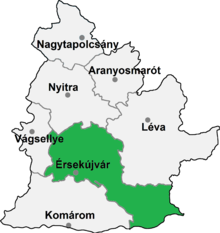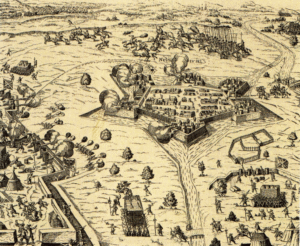Érsekújvár
Érsekújvár (Nove Zamky, Neuhäus(e)l) is situated in the historical Horná Zem/Felvidék region, in Slovakia. In the years 1545-46 and between 1573-81 a fortress was built on the site of an older settlement against the Ottoman Turks. It was the archbishop of Esztergom, Oláh Miklós, who had the fortress rebuilt. Archbishop means “Érsek” in Hungarian, while “újvár” means “new castle”.

You can read more about Oláh Miklós here:
https://www.hungarianottomanwars.com/essays/who-was-olah-miklos-1493-1568/

In the beginning, it was also called Oláhújvár, after its builder. The town grew up around the fortress. The huge new fortress was one of the most modern fortresses in Europe at the time of its construction, a prime example of the star-shaped fortress that had been adapted to the advance of artillery in the preceding centuries.

It was Cardinal Pázmány Péter who had the archbishop’s palace built here in 1620 to combat Protestantism. He consecrated the Franciscan church and monastery there. Érsekújvár had a well-fortified and modern castle and was therefore considered a strategic place near the Bohemian border.

The Ottomans failed to conquer it six times. However, they occupied it for shorter periods: between 1566-1595 and 1605-1606). They managed to take it again in 1663. Let us see how it happened:

In the fierce battle that followed, most of the soldiers of the garrison died and the insurgent nobles were driven out.


It became the center of an Ottoman vilayet in Upper Hungary. The saying “Strong as a Turk in front of Érsekújvár”, which means to work with determination and stability, reflects the memory of the Turks’ determination to conquer. In 1685 it was reconquered by the imperial troops of Charles V, Duke of Lorraine.
The retaking of Érsekújvár on 19 August 1685
The Habsburg military council decided to occupy Érsekújvár in the first half of 1685. Soon the army of General Donat Heissler besieged it and tried to starve the defenders. In fact, there was great hunger in the castle, but the garrison did not surrender.

On 7 July, the besiegers received reinforcements led by Duke Charles of Lorraine, and the systematic siege began. However, they could not continue undisturbed as the army of the Grand Vizier Sejtán Ibrahim arrived at the castle of Esztergom three weeks later. Prince Charles left a strong besieging army in Érsekújvár and took the other part of his army to defeat the Grand Vizier. You can read more about his victory here:
https://www.hungarianottomanwars.com/1541-1699/the-battle-of-tat-16-august-1685/
While Duke Charles was away, General Caprara was in charge of the besiegers. He continued to dig trenches, getting closer and closer to the walls. The defenders fought back desperately, causing the Imperials some casualties, but they could not stop Caprara. The cannons bombarded the walls from close range. The artillery fire destroyed the defenders’ cannons on 15 August. Two days later, Caprara was able to send cavalrymen against the demolished walls. He decided to launch a final and general assault with 3,000 selected men, but heavy rain forced him to postpone it until 19 August. The attack was so fierce that almost all the defenders died in the battle, while the Imperials suffered far fewer casualties.

Six years later it was granted town privileges by the Archbishop of Esztergom. The town also played an important role in many anti-Habsburg uprisings in the northern parts of Royal Hungary in the 17th century.
16 November 1704 The army of Bottyán János takes Érsekújvár
Since its reconquest from the Turks, the fortress of Érsekújvár has not been one of the best-built castles. After the siege (1685), the walls were replaced in many places only by palisade walls and the covered communication ditches were missing. The garrison was also one of the weaker troops of the imperial army, consisting of about 400-500 German infantry and 300 Hungarian Hajdú under the command of Colonel Baron Henrik Axmann.

The Hungarians of Érsekújvár were already in favor of the Kuruc rebels, but so were many of the Germans. Many of them had previously served at Munkács (Mukachevo) castle, so they knew and respected Rákóczi, like Major Ernst Härtl, who had already escaped from the castle in September 1704 and told Colonel Szentiványi János about the weaknesses of the castle, even saying that he and his whole troop would defect to the Hungarians. He told them that the cannons were in bad condition and could hardly be fired.

At the beginning of November, the parish priest Nagy Iván sent a plan of the castle to Bercsényi, who was in Selmecbánya. Meanwhile, the Kuruc leadership had a stroke of good fortune. Colonel Bottyán János, who had been a prisoner of war since the beginning of October and had sworn allegiance to Rákóczy in December of the previous year, escaped and went to the prince. Rákóczi immediately appointed the excellent officer, who was familiar with both the Borderlands and the Imperial style of warfare, as general, or rather, he simply confirmed his appointment from the previous year and ordered him to take Érsekújvár.

Bottyán had an excellent knowledge of Érsekújvár and its surroundings. (On one occasion, when the castle was still occupied by the Turks, he entered the castle in disguise, threw the muezzin from the minaret tower, and escaped through the gate). He had personal relations with many of the Hajdú soldiers and even became friends with the town judge, Bogyó Ferenc.

Bottyán’s spies thoroughly scouted the fortress. He found out that the weakest point of the fortress was between the White and the Bohemian bastions, so he directed his cannon fire there, as his artillery had been brought up from Szeged. He gathered his army at Ipolyság, and at the end of October, the prince himself brought 7-8000 men.

An important task was to isolate the army of General Siegbert Heister, stationed in the Csallóköz region between Komárom and Pozsony (Bratislava) so that the Kuruc forces would not try to liberate Érsekújvár. Bottyán therefore blocked the Danube crossings, deceived Heister with diversions, and reinforced the troops blockading Érsekújvár.

Around 5-6 November the bombardment of the fort began, with many shells falling on the weak points. Within a few days, the palisade walls had collapsed and the infantry attack could be prepared. The traitor Härtl had placed the Hungarian Hajdú troops at this point so that they could enter the fortress when the Kuruc forces attacked. Axmann had noticed this, but he did not dare to move the Hajdú soldiers from their position because of their rebellion. Instead, he barricaded himself with the German infantry in the central buildings of the castle.

On the night of 16 November, the Kuruc soldiers quietly descended into the moat and approached the walls. The Hajdú soldiers of the castle, led by Voivode Péter, Balkó János (leader of 30 men), and the officers Bogyó and Nagy Iván, lowered ladders and ropes and let in about 100 besiegers. They advanced with the Hajdús to the castle market, while Härtl opened the castle gates through which the prince’s army entered. Axmann and his handful of men surrendered without a fight. Only a few asked to be dismissed and most, led by Major Härtl, joined the Kuruc forces.

The prince appointed Härtl a lieutenant-colonel, gave him a vineyard and a house in Tokaj, and gave Bottyán a house in Érsekújvár as compensation for the manor in Esztergom confiscated by the emperor. He put Colonel Ebeczky Imre in command of the castle and ordered 200 infantry and 4 squadrons of hussars in addition to the 300 hussars. He had the damaged walls and trenches repaired and even had the fortress modernized with the help of French military engineers.

Rákóczi then took advantage of the enthusiasm generated by the successful siege to order the siege of Lipótvár Castle, which had been surrounded since September. Heister, however, could not ignore this and decided to counterattack.

After the War of Independence, Emperor Charles VI had the fort of Érsekújvár razed to the ground in 1724-1725 to prevent any further uprisings that might use the fortress as a base.
(Source: Szibler Gábor)

Dear Readers, I can only make this content available through small donations or by selling my books or T-shirts:
Please, feel free to support me with a coffee here:
You can check out my books "33 Castles, Battles, Legends" and "The Ring of Kékkő Castle" on Amazon or Draft2Digital, they are available in hardcover, paperback, or ebook: https://www.amazon.com/dp/198020490X or at https://books2read.com/b/boYd81
 My work can also be followed and supported on Patreon: Become a Patron!http://Become a Patron!
My work can also be followed and supported on Patreon: Become a Patron!http://Become a Patron!


https://hungarianottomanwars.myspreadshop.com/all

I



